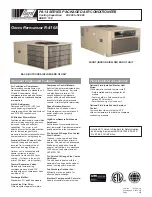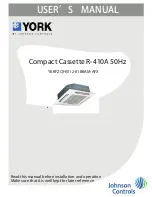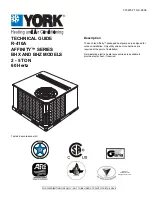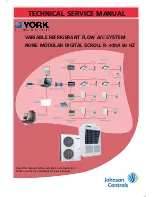
- -
15
Testing
1. Notes.
•
Installation MUST be complete prior to testing.
•
System MUST be tested prior to operation.
2. Leakage Test
•
Use standard A/C practices to properly check refrigeration tubes and connections for any leaks prior to system
start up.
3. Air Purging and Pressure Test
•
Remove bonnet (cover) of gas valve on outdoor unit.
•
Charge system with Nitrogen to 100 PSI and check for leaks. Evacuate Nitrogen.
•
Connect the gas valves of a vacuum gauge, vacuum pump, and outdoor unit
(see diagram). Start the vacuum pump and allow to run for at least 30 minutes at
a level of 500 microns or less.
•
Shut off the vacuum and continue to monitor vacuum gauge for another 15
minutes. The pressure should not rise above 800 microns.
•
lf a vacuum of 500 microns cannot be obtained, or if it rises above 800 microns
during the l5-minute monitoring period, pressurize the system with nitrogen and
look for leaks. Repair any leaks that are found and repeat the vacuum testing.
•
Close the valves to the vacuum pump and gauge and disconnect from the
outdoor unit.
•
Tighten bonnet (cover) of gas valve and open gas and liquid valves completely.
4. System Testing
•
Before testing the system, ensure that cut-off valves of the connection pipes are opened and that all debris (such
as packing scraps, thrums, etc.) are clear from the unit.
•
Switch on power to the system and press the ''ON/OFF'' button on the remote
control to activate the indoor unit.
•
Press ''MODE'' button repeatedly, taking a moment on each setting to ensure
that system functions in all modes. (Note: HEAT mode will function only on
heat pump models)
•
If the remote control is lost, emergency run operation can be initiated by
pressing the button in the upper right corner of the indoor unit under the cover
panel. (see diagram)
5. Installation Verification
•
Have both units been securely and firmly installed?
•
Are all piping connections secured?
•
Have the refrigeration lines been sufficiently insulated?
•
Have you verified the length of the connection pipes and the refrigerant capacity?
•
Have you conducted all leakage and system tests?
•
Does the unit drain properly?
•
Are all electrical connections in compliance with local standards?
•
Has the unit been properly grounded?
•
Is the power cord as specified?
•
Are all air inlets and outlets free from obstruction?
Summary of Contents for MS212A13115A
Page 3: ...2...






































